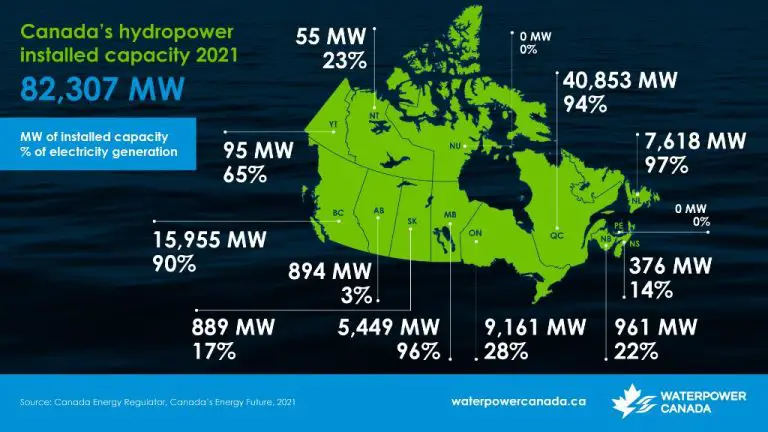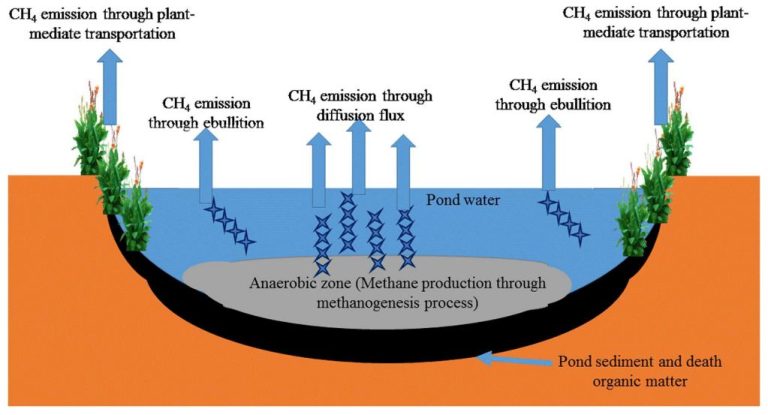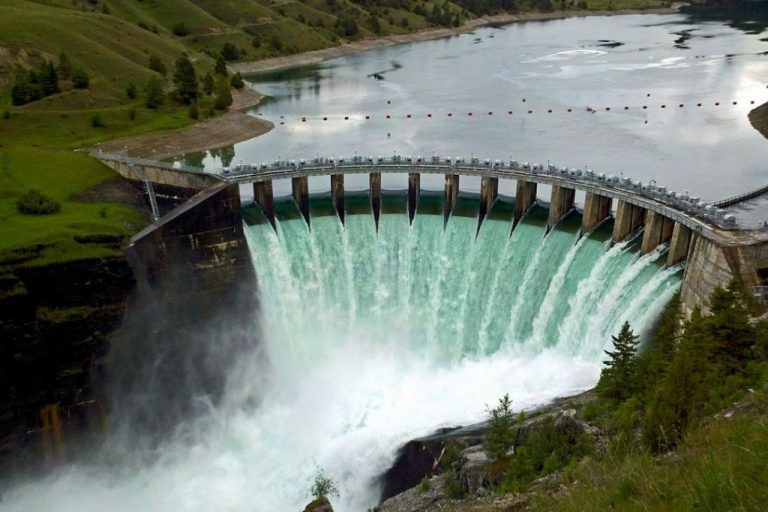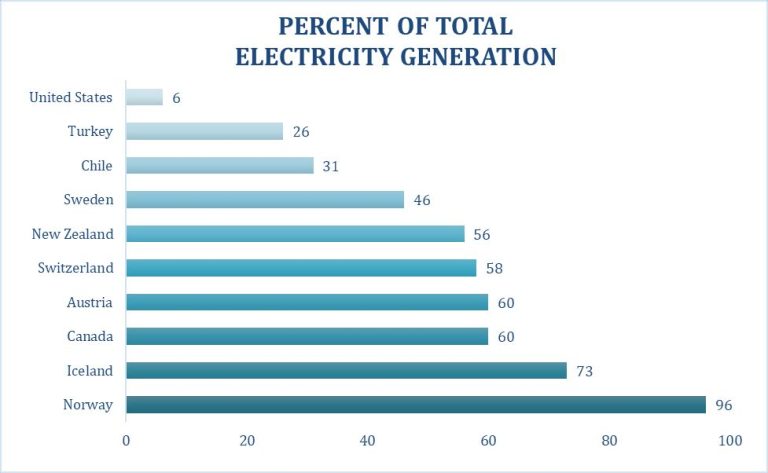What Country Has The Highest Hydro Electricity?
Hydroelectricity is the process of generating electrical power by harnessing the energy from flowing water. It is considered a renewable source of energy since it relies on the water cycle. Hydroelectric power plants capture the energy of falling or fast-flowing water to turn turbines and generate electricity.
Many countries pursue hydroelectricity because it offers a domestic, renewable source of energy that does not directly produce greenhouse gas emissions. Once hydroelectric power plants are constructed, the fuel source (flowing water) is free. This makes hydroelectricity a relatively low-cost way to generate electricity once the initial infrastructure is in place. Countries with significant river systems and elevation changes have strong potential for hydropower development.
What is Hydroelectric Power?
Hydroelectric power, also known as hydroelectric energy or hydropower, is electricity generated by hydropower plants using the energy from flowing water to produce power. Hydropower plants capture the kinetic energy created by falling or fast-moving water to run turbines connected to generators.
The basic principles of hydropower have been understood for centuries. Water wheels have been used for grinding grains into flour and to power machines for hundreds of years. In the late 19th century, hydropower began to be harnessed to generate electricity on a large scale.
Modern hydropower plants use dams and reservoirs to control water flow and funnel water through turbines. The amount of electricity generated depends on the volume and speed of the water flow as well as the size and efficiency of the turbines. The kinetic energy of the moving water turns the turbine shaft, which then spins copper wire coils inside an electromagnetic field to produce an electric current.
Today, hydropower supplies 16% of the world’s electricity from facilities ranging in size from small community plants to massive dams producing thousands of megawatts of power. Hydropower offers a renewable, emissions-free energy source that provides low-cost electricity around the clock in many parts of the world.
Benefits of Hydroelectric Power
Hydroelectric power has several major benefits that make it an appealing energy source. Three of the biggest advantages are that it is renewable, has low operating costs, and facilities have long lifespans.
Hydroelectricity is considered a renewable energy source because it relies on the water cycle. Rain and snow replenish the water in rivers and reservoirs used to generate electricity. As long as precipitation continues, hydroelectric power can be harnessed again and again [1]. Unlike fossil fuels which take millions of years to form, hydropower is a sustainable resource.
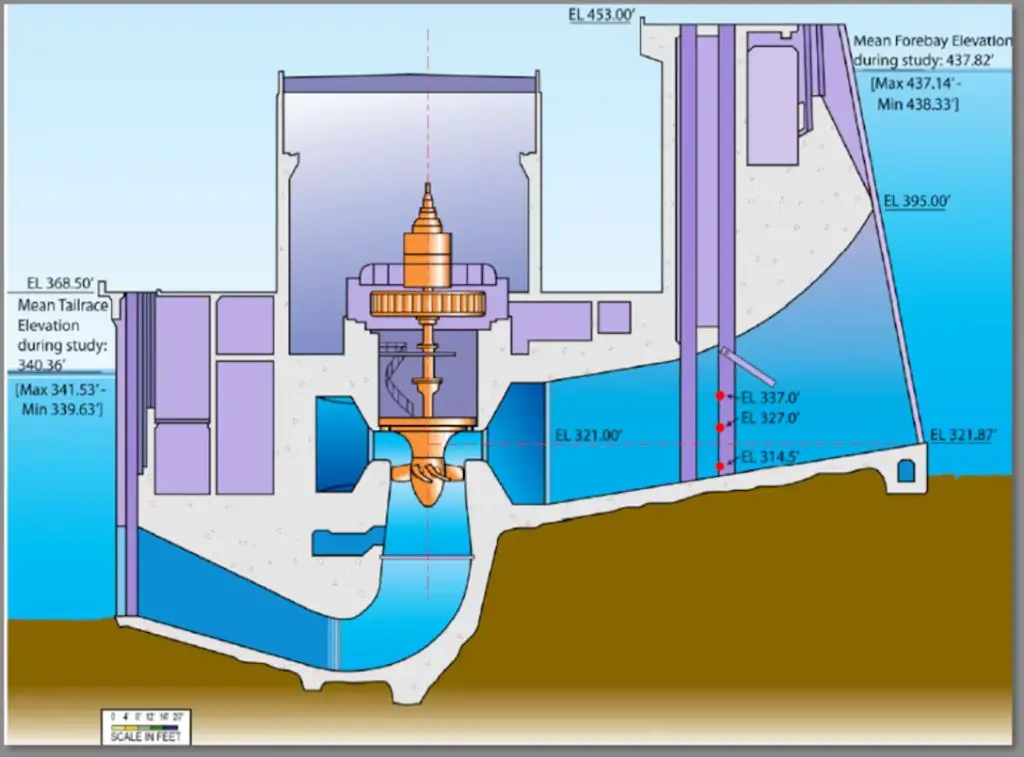
Once dams and other infrastructure are built, hydropower has relatively low operating and maintenance costs. The fuel itself, flowing water, is free. Facilities also do not require much staffing or equipment to keep electricity generation running smoothly [2]. This makes the cost per kilowatt-hour less than fossil fuel power plants.
Hydroelectric facilities are built to last many decades. With regular maintenance, dams, turbines, and other components have long lifespans well over 50 years. Investments in hydroelectric power continue producing low-cost renewable energy for generations [3]. The longevity provides reliable power production.
Downsides of Hydroelectric Power
While hydroelectric power has many benefits, there are also some downsides to consider. One major downside is that hydroelectric dams and power plants are very expensive to build. Construction costs tend to be high because massive dams, spillways, tunnels, and turbines are needed to harness the power of water flows. According to the Earth.org, hydroelectric power requires “high upfront investments” that can take decades to recoup.
Another significant downside of hydroelectric power is its impact on wildlife habitats. The reservoirs created by dams flood large areas that are home to terrestrial and aquatic species. Habitat loss and fragmentation occur, displacing animals and disrupting ecosystems. According to Kiwi Energy, this flooding impacts land animals by taking away trees and vegetation, while aquatic life suffers from changes in water quality, currents, and oxygen levels caused by the reservoirs.
Countries with Highest Hydroelectricity Generation
According to data from Statista, the top 5 countries for hydroelectricity generation in 2022 were:
- China – China generated a massive 1,274.63 billion kWh of hydroelectricity in 2021, accounting for over 30% of global hydroelectricity generation (Statista). With abundant water resources, China has heavily invested in hydro dams and stations to become the undisputed leader in hydroelectricity.
- Brazil – Brazil produced 362.82 billion kWh of hydroelectricity in 2021, making it the 3rd largest hydro producer globally. Hydro accounts for over 65% of Brazil’s electricity due to its extensive river systems like the Amazon and favorable terrain (Yahoo Finance).
- Canada – Canada generated 377.16 billion kWh of hydroelectricity in 2021, the 2nd highest globally. With immense hydro resources, hydro supplies 60% of Canada’s electricity demand. Major facilities are in Quebec, British Columbia, Labrador, and Manitoba (Global Economy).
- United States – The USA produced 260.22 billion kWh of hydroelectricity in 2021, ranking 4th globally. Major hydroelectric dams are located along the Columbia River on the West Coast and the Colorado River. Hydropower fulfills 7% of U.S. electricity needs (EIA).
- Russia – Russia generated 179.26 billion kWh of hydroelectricity in 2021. With Siberia’s powerful rivers and dams like Sayano-Shushenskaya supplying electricity, hydro accounts for 20% of Russia’s total electricity generation (International Hydropower Association).
China’s Hydroelectricity Generation
China has the largest installed hydroelectric capacity in the world at 390.9 GW as of 2021, including 36.4 GW of pumped storage capacity, according to Wikipedia. This is up from 233 GW in 2011. China’s hydro capacity accounts for over a quarter of total global hydroelectric capacity.
Some of China’s major hydroelectric dams include the Three Gorges Dam on the Yangtze River with 22.5 GW capacity, making it the world’s largest power station. The Xiluodu Dam on the Jinsha River has 13.9 GW capacity and the Xiangjiaba Dam has 6.4 GW. According to EIA, China’s pumped storage hydro capacity reached 50 GW in 2023, accounting for 30% of global pumped storage capacity.
China’s hydroelectricity generation has seen rapid growth, with annual generation reaching 1,314 TWh in 2020, up 51 TWh from the previous year according to Statista. This growth has been driven by large-scale dam construction and favorable policies supporting hydro power development.
Brazil’s Hydroelectricity Generation
Brazil is the second largest producer of hydroelectricity in the world, behind only China. As of 2021, Brazil had an installed hydroelectric capacity of 109 GW, accounting for over 65% of the country’s total electricity generation [1]. Major hydroelectric dams and power plants in Brazil include the 12.6 GW Itaipu Dam on the Parana River between Brazil and Paraguay, the 14 GW Tucuruí Dam on the Tocantins River, and the 11.2 GW Belo Monte Dam on the Xingu River [2].
Brazil has seen significant growth in hydroelectricity generation over the past decades. In the 1970s, hydro accounted for over 90% of Brazil’s electricity. This number declined to around 75% in the 1990s as other sources grew. But hydro has rebounded and now accounts for around 66% of total generation as of 2021 [3]. With abundant water resources, especially in the Amazon region, Brazil is expected to continue relying on hydroelectricity as a major component of its energy mix going forward.
Canada’s Hydroelectricity Generation
Canada has the third highest hydroelectricity generation capacity in the world, behind China and Brazil. As of 2019, Canada had 81 GW of installed hydroelectric capacity, producing about 400 TWh of electricity annually. This accounts for around 60% of Canada’s electricity generation. Some of Canada’s largest hydroelectric facilities include the Robert-Bourassa generating station with a capacity of 5,616 MW, the Churchill Falls generating station at 5,428 MW, and the La Grande-2-A generating station at 2,779 MW.
The province of Quebec alone has a hydroelectricity generation capacity of over 37,000 MW, mostly from large reservoir stations like the Robert-Bourassa facility. British Columbia also has significant hydroelectric resources with stations like the W.A.C. Bennett Dam. Overall, Canada has enormous hydro potential, especially in remote northern regions, and installed capacity continues to expand through new large-scale projects like the Site C dam in British Columbia currently under construction.
With abundant water resources like the St. Lawrence River and massive natural waterfalls, Canada has been able to rely heavily on hydroelectricity for clean, renewable power generation. Going forward, hydroelectricity is expected to continue supplying the majority of Canada’s electricity needs and remain an important export commodity to the United States.
USA’s Hydroelectricity Generation
The United States is one of the top producers of hydroelectricity in the world. According to the U.S. Energy Information Administration (https://www.eia.gov/energyexplained/hydropower/where-hydropower-is-generated.php), in 2022, total U.S. conventional hydroelectricity net summer generation capacity was about 79,980 megawatts (MW) or about 80 million kilowatts. This accounts for over 6% of total electricity generation capacity in the U.S.
Some of the major hydroelectric dams in the United States include the Grand Coulee Dam in Washington state, Hoover Dam in Nevada/Arizona, and Glen Canyon Dam in Arizona. The Grand Coulee Dam is the largest hydroelectric power producer in the United States with a capacity of 6,809 MW (https://en.wikipedia.org/wiki/Hydroelectric_power_in_the_United_States).
According to the U.S. Department of Energy (https://www.energy.gov/eere/water/hydropower-market-reports), hydropower capacity increased by a net of 431 MW in 2019. While growth has slowed compared to previous decades, hydroelectricity remains an important renewable energy source in the U.S. electricity generation mix.
Conclusion
Hydroelectric power is an important source of renewable energy globally. Looking at the top countries, China generates the most hydroelectricity in the world by a large margin, with over 1,100 TWh produced annually from its massive Three Gorges Dam and other hydro plants. Brazil comes in second for hydro generation, producing around 380 TWh per year from facilities like the Itaipu Dam on its border with Paraguay. Canada takes the number three spot, with an estimated 380 TWh of hydroelectricity, largely from dams and hydro plants in its many river systems. The United States generates the fourth highest amount of hydro power, around 250 TWh annually.
Overall, hydroelectricity provides a major clean energy source that helps reduce dependence on fossil fuels. The top hydro countries demonstrate the viability and potential of hydro power to meet electricity demands through renewable means. However, all countries must also balance hydro plant infrastructure with environmental impacts. With careful planning and sustainable practices, hydroelectricity can continue serving as an efficient way to generate electricity for years to come.

